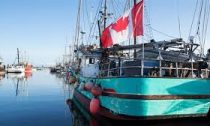
Oceana Canada’s latest annual report on the state of Canada’s fisheries was released today, revealing that the health of fish populations has declined over the past three years and the government is not acting with the speed and rigour needed to rebuild depleted stocks. Unless this changes, Canada cannot ensure a sustainable seafood industry or one that can adapt to global threats to the ocean, such as climate change, pollution and habitat destruction.
Fishery Audit 2019 provides an in-depth analysis of the state of Canada’s fisheries and tracks progress on how well the government is meeting its policy and management commitments.
Since its launch in 2017, the number of fish populations in a critical state has increased to 17 per cent (from 13.4) and the number that are considered healthy has decreased to 29.4 per cent (from 34.5).
More crustaceans entered the critical zone in 2019, which is particularly worrying because the value of Canada’s seafood industry depends heavily on crustacean fisheries. According to Fisheries and Oceans Canada (DFO), just three groups of crustaceans – snow crab, lobster and shrimp – account for 73 per cent of total fisheries landings, worth approximately $3.8 billion.
“Healthy fish populations are critical to healthy ecosystems and coastal communities. They support economies and are an essential source of sustainable protein for millions of people. However, our oceans are facing growing threats and greater uncertainty, putting the marine life we all depend upon at risk,” says Dr. Robert Rangeley, science director at Oceana Canada. “A lot is at stake, and it’s time for the government to take stronger action now to manage fisheries sustainably. We can rebuild populations to provide more opportunities for coastal communities and make them more resilient to climate change and other growing threats.”
Fishery Audit 2019 shows that DFO has not implemented many proven tools needed to rebuild depleted fish populations. For example:
- The health of 38.1 per cent of Canada’s fish populations cannot be determined due to a lack of government information, making it impossible to manage them effectively;
- Only 18.2 per cent of Canada’s depleted fish populations have plans in place to rebuild them to healthy levels;
- Fewer than half of DFO’s stated priorities were achieved in 2019 (up from only 25 per cent in 2018); and
- In 2019, DFO increased the quota for the critically depleted northern cod, ignoring scientific advice and its own policy to keep all sources of fishing mortality on depleted stocks to the lowest possible level. This approach neglects the potential that sustainably managing the population could unlock. If rebuilt, it could support 16 times more jobs and provide five times more economic value.
Despite these worrying declines, some important progress has been made since Oceana Canada’s last Fishery Audit was released. Most importantly, a modernized Fisheries Act became law in June 2019. For the first time in its history, rebuilding plans will be required for depleted fish populations. The government has also committed more than $100 million over five years to assess and rebuild fish populations.
“This new investment and a legal requirement to manage fish populations sustainably, if backed up with strong regulations to ensure the law is appropriately enforced, could signal an historic turning point in the health of Canadian fisheries,” says Josh Laughren, executive director at Oceana Canada. “This provides a rare opportunity for ambitious progress in 2020 and beyond.”
To seize Canada’s opportunity to rebuild fish populations, Oceana Canada is calling on DFO to:
- Complete the Fisheries Act rebuilding regulations to bring the new provisions into force, including requiring targets and timelines for rebuilding plans;
- Address inconsistencies in catch monitoring by implementing the long-awaited national fishery monitoring policy;
- Develop and implement high-quality fishery rebuilding plans for critical stocks that include targets and timelines; and
- Complete all deliverables outlined in DFO’s fiscal year workplans.
Visit FisheryAudit.ca to view the full report, see stories from coastal communities and learn how we can rebuild abundant oceans.













Social Profiles